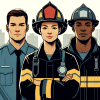Many interview candidates don’t realize how important the perception of their body and voice are during an oral board interview. The fastest way for an oral board panel to lose engagement with a candidate’s answers is for them to be monotone and stiff.
When I work with potential candidates, they quickly realize the interview process is much more difficult that it appears. The oral board interview process is a one-way conversation, and that plays havoc on a candidate’s ability to be comfortable and communicate in a typical fashion.
There are some basic skills that candidates need to practice to improve their overall body and voice perception.
Body position: Be natural. A candidate who appears stiff and tense will often have a difficult time communicating and articulating answers.
Relax your body posture, but not to the point of laziness. Rocking in chairs and slouching should be avoided. A relaxed, confident body posture is the ultimate goal.
Practice looking at your body position as you speak and answer questions. Use a video camera to pick up on distracters that may take panel members’ attention away from your answers.
Voice infection: A candidate must be comfortable communicating without verbal feedback from the panel. A boring, monotone answer receives a score that will be just that.
Use good voice inflection, excitement, passion and confidence with your answers. You have 20-30 minutes to convince the panel that you are the candidate to hire.
Eye contact: When candidates are not prepared, they look down, up or away from the panel. This allows their brains to formulate the next thought because they are searching rather than being fluid with their answers through practice and repetition.
Never lose eye contact and engagement with the panel. Work the panel with your eyes, even if the raters are looking down at their score sheets or don’t seem engaged.
If the panel is engaged with your answers, this is your best chance to get some non-verbal communication from the panel. This can give you some insight on how you are answering questions.
Non-verbal feedback: During your interview, read the panel for non-verbal feedback to help you evaluate your interview. Facial gestures, eye movements, smiles and head nods are all ways the candidate can determine if the panel is engaged.
Once you have the panel members engaged, don’t lose them. Keep working the panel.
Hand gestures: Hand gestures can help you look relaxed, comfortable and confident. Be careful not to be too flashy.
Practice: It is imperative that any candidate practice their body and voice perception continually. Use a friend, a video camera, a tape recorder and — my favorite — a mirror. Speak in front of crowds whenever possible to work on your presentation style and to become more comfortable with public speaking.
With these tips any candidate can improve oral board interview scores and be closer to a badge. Success is no accident.


